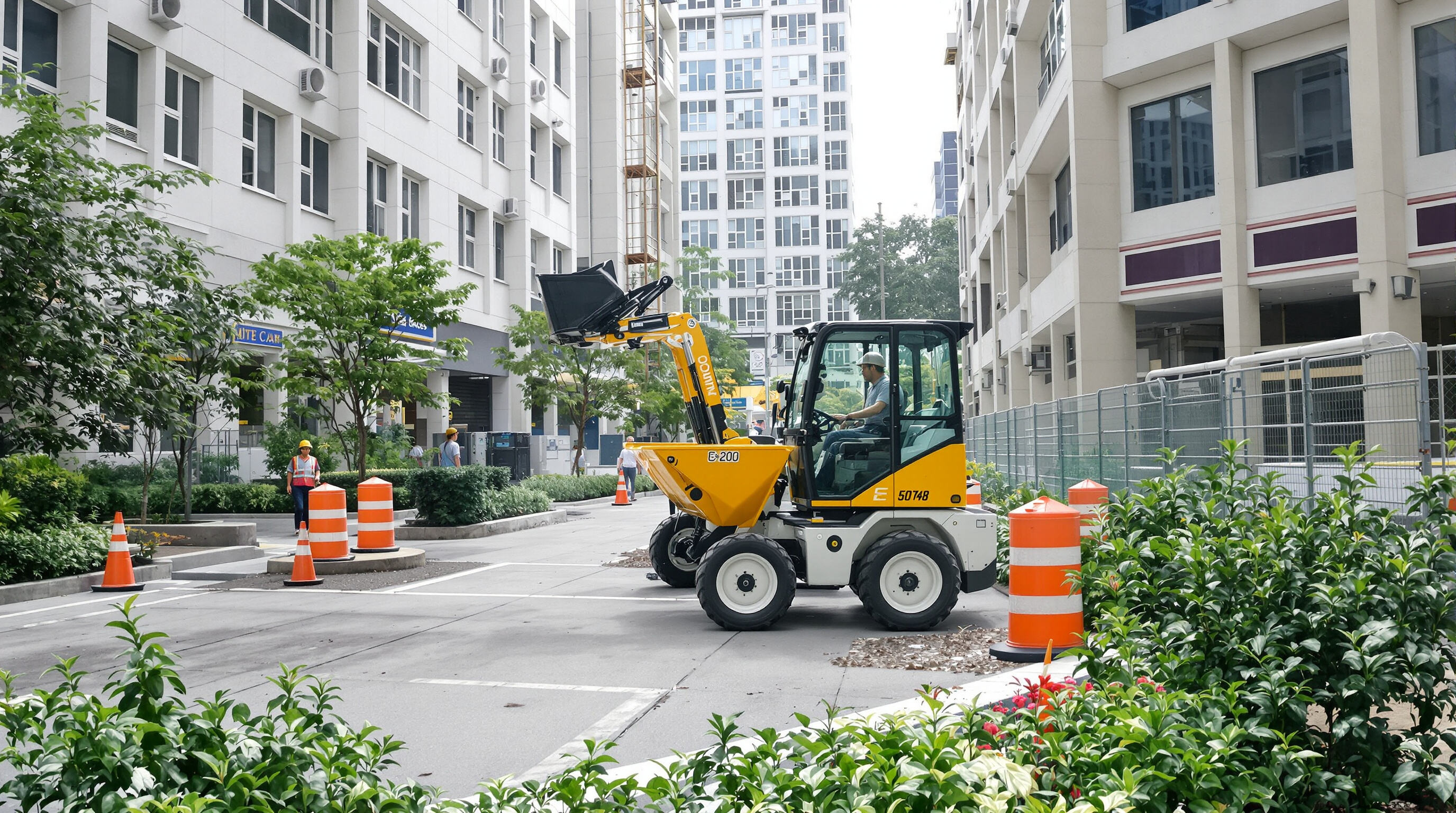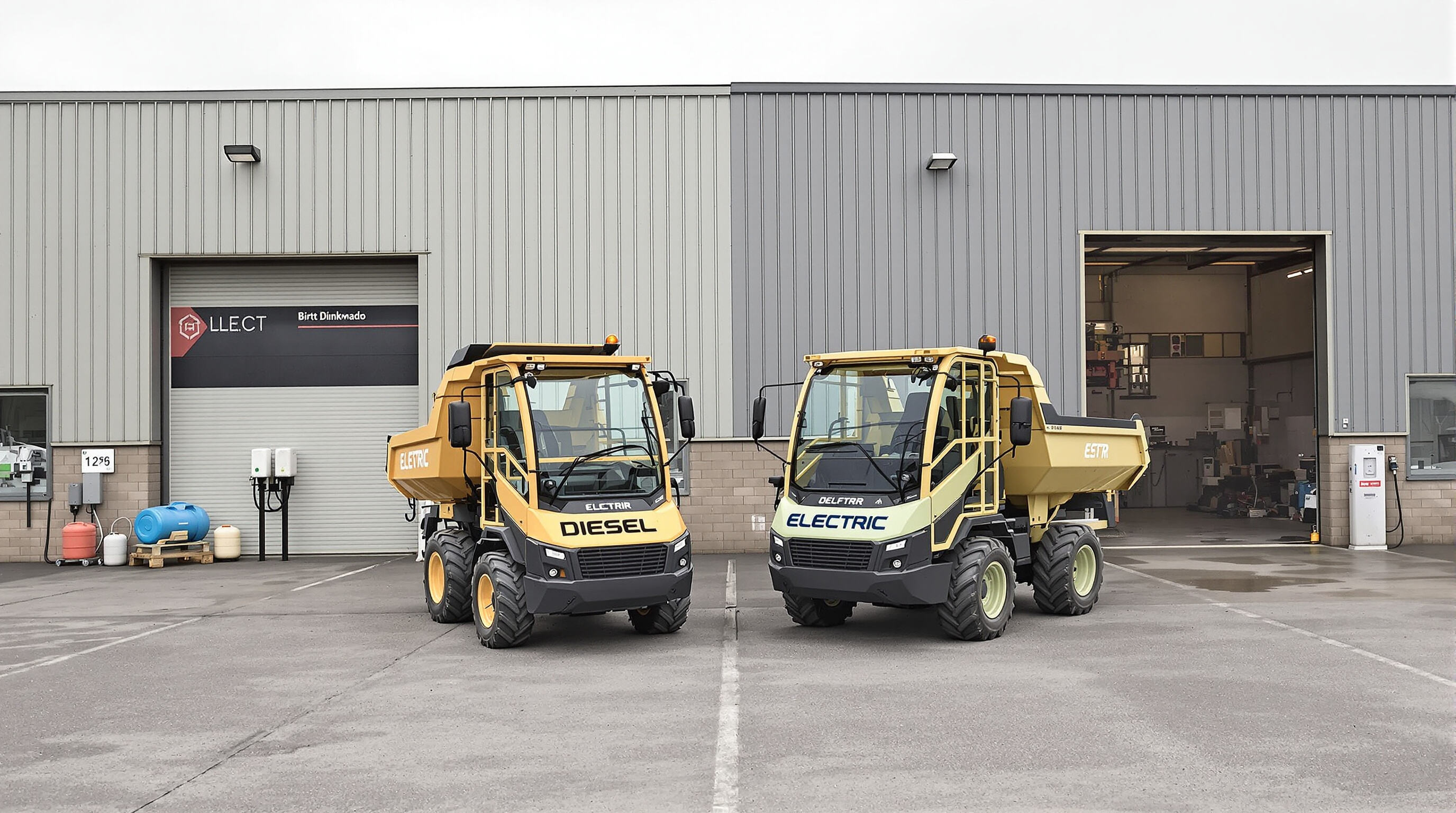העלאת מכשורים חשמליים קטנים בבניית ימינו
איך הגלובליזציה מעוררת ביקוש לציוד קטן ובלתי זיהמי
בערים מתפתחות במהירות בימינו, מה שפירושו ששדות הבנייה קטנים ומורכבים יותר. לפי דוח התעשייה לשנת 2023, כשלושה מתוך ארבעה פרויקטים תשתיתיים מתרחשים במרחבים עירוניים צפופים בהם אין די מקום. כאן נכנסים לפעולה מקלטי הפסולת החשמליים הקטנים. מכונות קטנות אלו נכנסות בקלות למרחבים צפופים מבלי להפיק פליטת רכמים, כך שקבלנים יכולים לעבוד תוך עמידה בתקני איכות האוויר החמורים כפי שנקבעו בפריז ובברלין. מה שמייחד אותן במיוחד הוא היכולת לנוע במבואות הצרים שבין בניינים ולתפקד בצורה תקינה גם בתוך מבנים. מפתחים עירוניים סומכים עליהן רבות לצורך מגוון עבודות, החל מהרחבת מערכות הרכבת התת-קרקעית וכלה ביצירת מרחבים ירוקים על גגות בניינים במרחבים עירוניים צפופים.
צמיחה בשוק העולמי: מגמות מכירת מקלטי פסולת חשמליים קטנים (2020–2024)
ציוד בנייה חשמלי צבר צמיחה משמעותית בתקופה האחרונה, עם קצב צמיחה שנתי ממוצע של 18.5 אחוזים עד לשנת 2024. מקלעים קטנים היו פופולריים במיוחד בקרב בוני בתים ופרויקטים של ממשל מקומי. השלב הקריטי התרחש כאשר הקונגרס העביר את חוק ההשקעה והabajות הענק בשווי 1.2 טריליון דולר, מה שהאיץ מאוד את התהליך. מחלקות למשרדי רשות קיבלו 40 אחוזים יותר הזמנות למקלעים חשמליים קטנים בהשוואה לעבר. מעבר לצפון אמריקה, מדינות מתפתחות מייצגות כרגע כ-35 אחוזים מכלל הביקוש החדש. ערים כמו מומבאי ובנגקוק משקיעות מאמצים משמעותיים בהפחתת רמות הזיהום, במיוחד במהלך מסעי הבנייה של כבישים וגשרים המתבצעים בערים.
מקרה לדוגמה: אימוץ של מקלעים חשמליים קטנים בפרויקטים תשתיתיים באירופה
עבודות תת-קרקעיות במערכת מנהרות גדולה מתחת לבריסל הפחיתו את צריכה של דיזל בכ-שני שלישים כאשר מחליפים 14 משאיות שפיכה ישנות בגרסאות חשמליות. העובדים שמו לב שהמעגלים שלהם היו מהירים ב-28 אחוזים בערך, מאחר שהמכונות החשמליות מתחילה לפעול באופן מיידי ללא צורך לחכות להתחממות המנוע, וכן אין צורך לעצור באמצע הפסקת הצהריים כדי למלא מחדש את הטנקים. מה שהתחיל כפרויקט מוצלח אחד הוביל עכשו לכללים חדשים באירופה שקובעים שכל פרויקט עבודה ציבורי שמעל חמשה מיליון דולר חייב להשתמש במכשור חשמלי. וזה לא קורה רק באירופה - שנים עשר מדינות אסייניות יישמו יוזמות ירוקות דומות מאז תחילת השנה שעברה, מה שמראה כמה מהר הדברים משתנים בעסקים במבנה ברחבי העולם.
הטבות סביבתיות ורגולטוריות של שופכות מינון חשמליות

השגת אפס פליטת פלטפורמה עם פעולות שופכת מינון חשמלית
משאיות מיני חשמליות פועלות בצורה נקייה לחלוטין בעת העברת חומרים באתרי עבודה, ומחסלות גזי פליטה לא נעימים כמו תחמוצות חנקן (NOx) וחלקיקים עדינים שכולנו יודעים שהם מזיקים לריאות שלנו. העובדה שמכונות אלו אינן מזהמות הופכת אותן לחיוניות עבור עבודות בנייה עירוניות שבהן כללים מקומיים אוסרים לעתים קרובות על ציוד דיזל מסורתי. עובדים יכולים כעת לפעול בתוך חללים צרים כמו מנהרות תת-קרקעיות או ליד אזורים רגישים כמו בתי חולים ובנייני דירות מבלי לדאוג להפרת חוקי הסביבה. המעבר מיחידות דיזל מהדור הישן עושה גם הבדל של ממש. דגם חשמלי אחד מפחית את פליטת הפחמן הדו-חמצני בכ-8 טון מדי שנה בהשוואה למה שהיה קורה אחרת. בנוסף, אף אחד לא נחשף לחלקיקי פיח מסרטנים שמסתובבים אחרי שמנוע דיזל מפעיל את מסלולו.
הגשמת סטנדרטים של EU Stage V ו- EPA באמצעות אלקטרופיקציה
שינויים רגולטוריים ברחבי העולם דוחפים חברות בנייה לעבר משאיות מיני חשמליות משום שהן צריכות לעמוד ביעדי פליטה מחמירים. כללי Stage V של האיחוד האירופי ותקני Tier 4 של ה-EPA האמריקאי דורשים כמעט ולא פליטות חלקיקים כלל, דבר שניתן לעשות רק עם מכונות חשמליות. קחו לדוגמה את תוכנית 2030 של ה-EPA - אתרי בנייה צריכים להפחית את הפליטות שלהם ב-40 אחוזים תוך מספר שנים בלבד. במקביל, מאמצים עולמיים להפחתת פליטות פחמן גורמים לעניין גובר בציוד שאינו מייצר גזי פליטה. משאיות מיני חשמליות משתלבות בדיוק בתמונה זו, שכן הן עוזרות לחברות לעמוד בתקנות ועדיין לספק ביצועים טובים באתרי עבודה.
איזון השפעת ייצור הסוללות עם שגשוג בר קיימא לטווח ארוך
ללייתיום-יון סוללות יש השפעות סביבתיות עקב כל החפירה הנדרשת לחומרים, אך בחינה כוללת מציגה כי מיני-לוארים חשמליים עדיין מציעים קיימות טובה יותר בכלליות. רוב פוטבולטים הפחמן שנוצרים בייצור מושלמים בקצרה - בדרך כלל בין 18 ל-24 חודשים לאחר שמפסיקים לשרף דיזל וצריכים פחות תחזוקה שוטפת. כשמכונות אלו פועלות כ-שבע שנים, הן מפיקות כמחצית מהזיהום בהשוואה לדגמים המונעים בדיזל, לפי מחקרים בתעשייה. טכנולוגיות מחזור עשויות התקדמות רבה לאחרונה, ומחזירות כמעט את כל החומרים מהסוללות הישנות. בנוסף, חברות רבות עוברות על מקורות אנרגיה ירוקים בתחנות הטעינה, מה שעושה את הפעולה אפילו נקייה יותר. שיפורים אלו עוזרים ליצור מערכות שבהן פסולת הופכת למשאב, דבר שאליו מתחילים לעבור חברות הבנייה בשרשראות הרכב שלהן, למרות מכשולים ראשוניים הקשורים לשינויים בโครง התחזוקה.
יתרונות תפעוליים של המנקה המינית החשמלית
הפחתת זיהום רעש והabilitה לבנייה עירונית 24/7
מנקות מיניות החשמליות מפחיתות את הרעש במחצית עד שלושה רבעים בהשוואה לאלה המונעות בדיזל, מה שעושה אותן מאוד מועילות בשכונות עירוניות עירומות שבהן רעש מכוניות הוא בעיה. ההפרש ברמות הרעש נע סביב 68 דציבל או פחות ליחידות חשמליות לעומת יותר מ-85 דציבל מהמנועים התרמיים המסורתיים, כך שקבלנים יכולים למעשה לעבוד בלילה המאוחר מבלי לקבוע קנסות על הפרות רעש. קחו לדוגמה את שיקום אזור אלכסנדרפלץ בברלין בתקופה האחרונה, שם המנקות החשמליות אפשרו להמשיך בحفירה גם בלילה תוך שמירה על הגבול האירופי של 70 דציבל גם לאחר שעת העروب ב-10 בערב. לפי אנשים התורמים בענף, פרויקטים באזורים עם תקנות רעש קפדניות נוטים להסתיים מהר בכ-18 אחוז כשהם לא תקועים בעקבות אותן חוקים מטרידים של עבודה רק בوقת היום.
ביצועים מוגזמים: טורק מיידי ובלימת שיקום
המנועים החשמליים מספקים טורק מלא כבר מ-0 סל"ד, מה שאומר שה_DUMPERS הקטנים האלה יכולים לטפל במדרונות של 30 מעלות גם כשהם נושאים את המטעൻ המרבי שלהם. זה בערך 12 אחוזים טוב מהדיזל הרגיל. מערכת הבלימה השיקומית בעצם אוספת בערך 15 עד 20 אחוזים מהאנרגיה כשיורדים במדרון, אז לא חייבים להטעין אותם כל כך הרבה במהלך היום. מבחנים בשטח מציגים גם תופעה מעניינת. הדגמים החשמליים ממשיכים לנוע במהירות של כמעט בדיוק 10.5 קמ"ש בערך בכל תנאי קרקע, בעוד שהמכונות הדיזלויות הישנות מתמודדות הרבה יותר, ומציגות שונות של בערך 22 אחוזים במהירות בגלל שההילוכים שלהן צריכים זמן להתחבר וכשהן עובדות קשה הן נוטות להתחמם.
מקרה לדוגמה: עליית תפוקה בפרויקט הרחבת המטרו במומביי
ניסיון בן 14 חודשים עם 20 מקלטים חשמליים בפרויקט קו 3 הוכיח:
| מטרי | יחידות חשמליות | בסיס דיזל | השפרה |
|---|---|---|---|
| שעות פעולה יומיות | 19.2 | 14.5 | +32% |
| עלויות דלק/תפעול | ₹340,000 | ₹680,000 | -50% |
| חומר שנשאבה בכל משמרת | 48 טון | 41 טון | +17% |
הפעולה השקטה אפשרה חפירה מתמדת בסמוך למגדלי מגורים, וה prevnta קנסות על הפרת רעש בשווי ₹1.2 crore. מנהלי הפרויקט השיגו זמינות ציוד של 95% לעומת 78% בציי דיזל, מה שמהיר את השלמת השלב ב-11 שבועות (דוח רשות התכנון של הרכבת התחתית 2023).
עלות בעלות כוללת: חשמלי مقابل דיזל מיני דמפרים

השקעה ראשונית: השוואת עלויות רכישה
דמפרים חשמליים קטנים מחייבים בדרך כלל עלות ראשונית גבוהה ב-60–100% בהשוואה לדגמים דיזליים, כאשר דגמים ביניימים נמצאים בממוצע 200,000–240,000 $ verses 150,000–180,000 $ לחלופות המסורתיות. עם זאת, הפער מצטמצם משמעותית כאשר נלקחים בחשבון ההנחות ממס וخيارات השכרה של ציוד הזמינות ב-65% מהמדינות בארצות הברית למכונות נטולות פלט.
חיסכון ארוך טווח בדלק ובתפעול
הכלכלה התפעולית משנה את המשוואה ה_financial:
- עלות דלק לדגמים חשמליים פועלים 25–30% מما שווה לדגמים דיזליים, חוסכים $10,000–$15,000 בשנה לכל יחידה
- הוצאות תחזוקה יורדות 4060% על ידי ביטול החלפת שמן, תיקוני מערכת הפליטה, והחלפת מסננים לת PARTICULATE
א מחקר האלקטרופיקציה לשנת 2024 מצא שקומפרסורים חשמליים הקטינו את הוצאות הדלק השנתיות מ $6,500 (דיזל) ל 3,350$ בעוד הכפלת תקופות השירות.
תROI מהירה יותר על אף עלויות ראשוניות גבוהות
ניתוח עדכני מראה כי מזבלות מיניות חשמליות משיגות שוויון החזר בהשקעה תוך 18–32 חודשים באמצעות חיסכון בתפעול, מעבר לדגמי דיזל 5 שנות+ שעורי ה-ROI. האצה הזו נובעת מ:
- הסרת תנודות מחירים של דיזל ( תנודות שנתיות של 18% מאז 2022)
- אורך חיים מוגזם של רכיבים (מנועי תמסורת חשמליים נמשכים 2.3– יותר מאשר מהמכשורים)
נתונים מהתפעול של מכרות מובילים מציגים 15–20% נמוך יותר בעלויות החזקה הכוללות לכליות חשמליות לשעת כוח במהלך 7 שנים, מאמתות את חישוב ה-ROI של האלקטריפיקציה בקונסטרוקציה.
חדשנות המגשימה את הדור הבא של מקלחות מינון חשמליות
טלקומטיקה חכמה ותפעול מרחוק לאופטימיזציה של צי מוניות
מערכות טלקומטריה משנות את האופן שבו פועלים מקלטים חשמליים קטנים באתרי בנייה בימינו. בעזרת זיהוי מיקום ב-GPS בזמן אמת, סטטיסטיקות ביצועים, וכמו גם התראות מוקדמות על צרכים תחזוקתיים, מפעילים יכולים לשמור על תפקוד חלק. הטכנולוגיה החכמה עוקבת אחרי רמות האנרגיה של הסוללות, מזהה מכשורים שלא משמשים מספיק, ואפילו תכנן תיקונים מראש לפני שבעיות נוצרות. דוח עדכני משנת 2024 שמגיעה מהאגף חדשנות בתעשייה מציג גם הוא מספרים מרשימים. אתרים שמטרים את ציודם באופן מרחוק מגלים ירידה של כ-30 אחוזים בשעת השבתה הכוללת, וכמו גם הפחתה של כ-25 אחוזים בתאונות כאשר משתמשים בטכנולוגיית ג'יאו-휀סינג ובمراقبה על אופן השימוש במכשורים על ידי המפעילים. כל נתונים אלו תורמים להחזר הון טוב יותר על הרכוש, וכן מקילים על הפצה של משאבים לשם היערכות טובה בין פרויקטים שונים.
אינטגרציה עם BIM ותוכנות ניהול בנייה
מקשה חשמלית קטנה תואמת כעת פלטפורמות של BIM, מה שמאפשר לעקוב אחרי מה שקורה באתר לעומת התכנון הדיגיטלי. כשהמכונות מחוברות, הן מנהיגות את לוחות הזמנים של תחבורה של חומרים על פי מודלים תלת-ממדיים של אתרי בנייה. הן גם מסנכרנות את תנועתן עם מנופים ומעדכנות את רישומי המלאי מבלי שיהיה צורך בכך ידנית. הסרת טעויות תיאום אלו מצמצמת עבודה מיותרת, אולי בכ-18% פחות לפי מחקרים מסוימים. בנוסף, החומרים מגיעים בדיוק בזמן הנכון ולנקודה הנכונה באתר, מה שגורם לכל התהליך לרוץ חלק יותר עבור הקונטראקטורים.
מערכות סוללות ניתנות להחלפה להפעלה רציפה
עם טכנולוגיית סוללות מודולרית, עובדים יכולים להחליף מקורות כוח בתוך ארבע דקות בלבד, ללא המתנה לרוכש בזמן החרום הזה שבו כל שניה נספרת. תכונת ההחלפה החמה שומרת על הפעילות גם במהלך ימי עבודה ממושכים, משהו שמשנה את כל ההבדל באתרי בנייה עירוניים שבהם הגבלות רעש מקבלות חלק מהזמן הזמין לעבודה. חבילות סוללה סטנדרטיות פירושן שחברות אינן נאלצות לזרוק את כל המערכת שלהן כשהופכות זמינות סוללות טובות יותר. בהסתכלות על הנתונים מבדיקות בשטח, מערכות כאלו אכן מגדילות את זמני הפעולה היומיים בכ-40 אחוז לעומת עיצובים ישנים של סוללות קבועות. בנוסף, יש חיסכון במבנה התשתית מאחר שעסקים אינם נאלצים לקנות ציוד חדש שוב ושוב רק בגלל שטיפולי הסוללה השתפרו.
שאלות נפוצות
למה גלגילים חשמליים קטנים הופכים לפופולריים בבנייה מודרנית?
מטענים חשמליים קטנים זוכים בפופולריות בשל גודלם הקטן והיכולת לפלוט אפס פליטת פחמן. הם אידיאליים לאתרי בנייה עירוניים בהם מוגבלת השטח ותקנות איכות האוויר קשוחות.
האם מטענים חשמליים קטנים משתלמים כלכלית בהשוואה למטענים דיזליים?
למרות שמטענים חשמליים קטנים יקרים יותר בהתחלה, הם מציעים חיסכון משמעותי בטווח הארוך בדלק ובתפעול. הם משיגים תשואה מהירה יותר בהשוואה לדגמים דיזליים בשל הוצאות תפעול נמוכות יותר.
איך מטענים חשמליים קטנים משפיעים על זיהום רעש?
מטענים חשמליים קטנים מפחיתים משמעותית את זיהום הרעש, ומאפשרים תפעול 24/7 בסביבות עירוניות מבלי לפגוע בתקנות הרעש.
מהם היתרונות הסביבתיים של שימוש במטענים חשמליים קטנים?
מטענים חשמליים קטנים מוסרים את הפליטות דרך הפלט, מה שמעודד את איכות האוויר. הם עונים לתקנות עולמיות שמטרתן הפחתת פליטת פחמן וחלקיקים.

